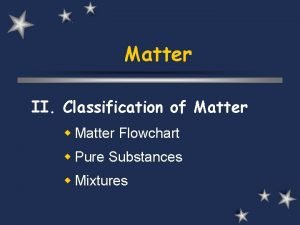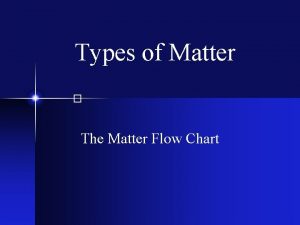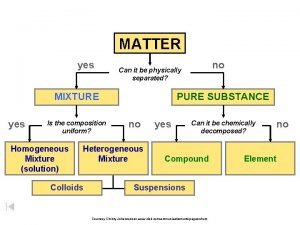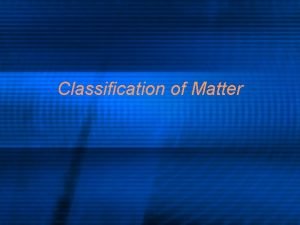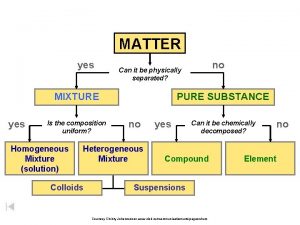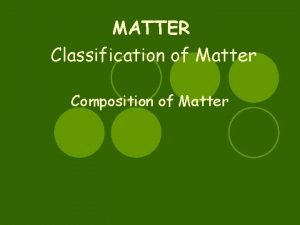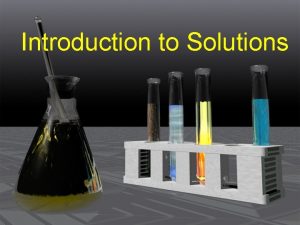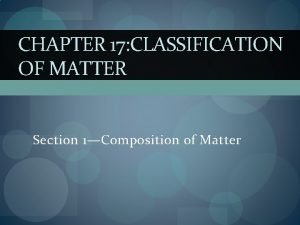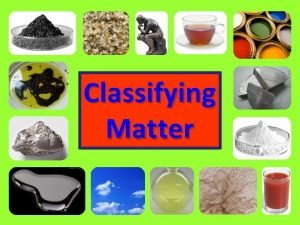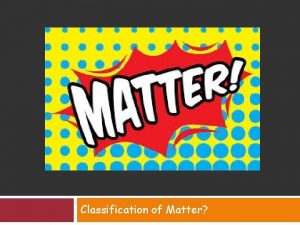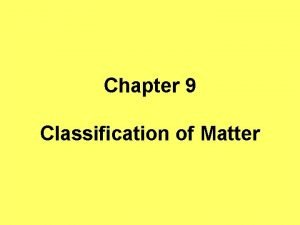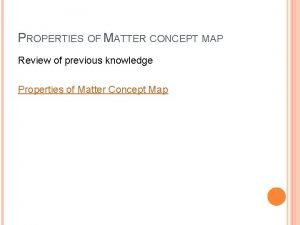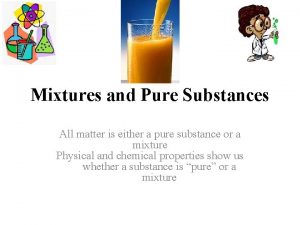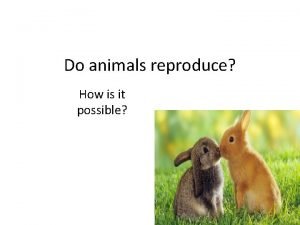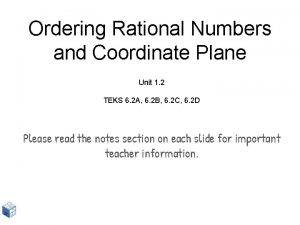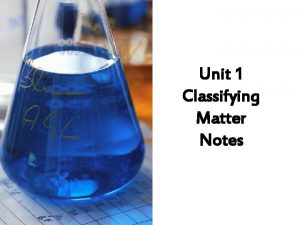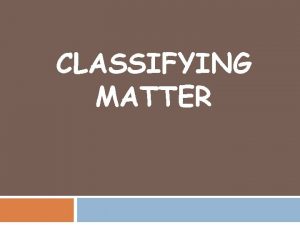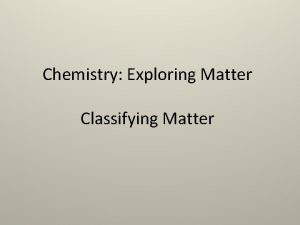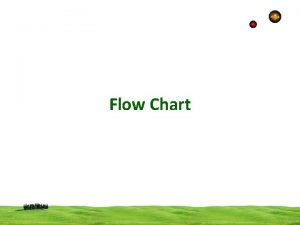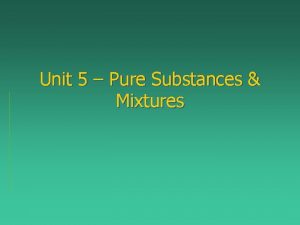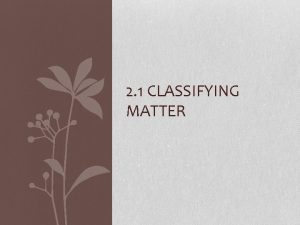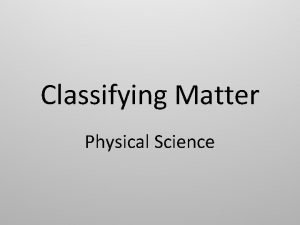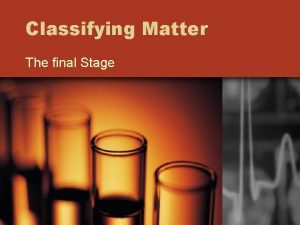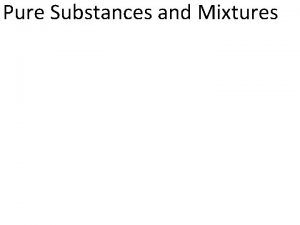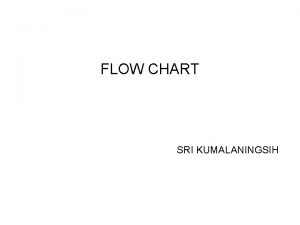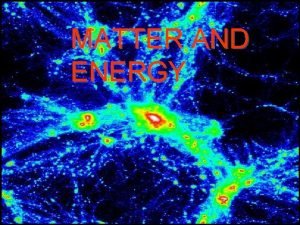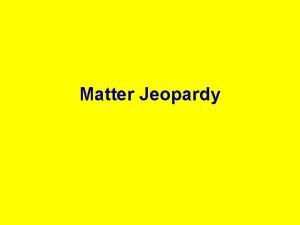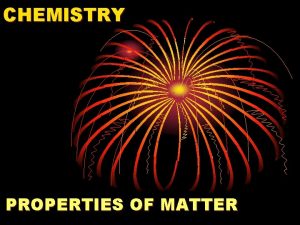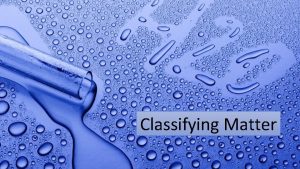Unit 1 Classifying Matter Notes Flow chart Pure

























- Slides: 25

Unit 1 Classifying Matter Notes

Flow chart

Pure Substances (elements and compounds) 1. EVERY SAMPLE of a given pure substance has EXACTLY THE SAME characteristic properties. a. Boiling point b. Freezing point c. Melting point d. Density 2. Can NOT BE SEPARATED by PHYSICAL means Ex: water always has a boiling point of 100 C, melting point of 0 C, freezing point of 0 C and a density of l. 00 g/ml. Other pure substances have their own individual characteristics (bp, mp, fp, density)




Mixture – 1. Not the same as a compound. Usually composed of several substances. 2. CAN be separated by PHYSICAL means 2 kinds of mixtures


1. Homogeneous mixtures – also called solutions have the same composition throughout. Ex: salt water


How Solutions are Made…



2. Heterogeneous mixtures – the composition is NOT the same throughout; Ex: blue cheese dressing, sand water, trail mix


Learning Check: Identify the following as pure substances (p) or mixtures (m): P Oxygen (O 2) ___ M Lemonade ___ M Snickers bar ___ P Distilled water ___ P Dry ice ___ M Soil ___

Learning Check: Classify the following as Homogeneous (ho) or Heterogenous mixtures (he) Ho Pure Air ___ He Salsa ___ He Chocolate chunk ice cream ___ Ho Ink ___ Ho Blood ___ He Chicken noodle soup ___

Physical Separation: Separates MIXTURES 1. Distillation – based on differences in boiling point: separating a mixture of alcohol and water. Alcohol has a lower boiling point than water so it will boil off sooner. Both substances will be retained

Physical Separation: Separates MIXTURES 2. Filtration – based on differences in solubility and particle size -liquid is passed through materials with very small holes to strain out particles.

Physical Separation: Separates MIXTURES 3. Chromatography – based on differences in polarity Example Video

Physical Separation: Separates MIXTURES 4. Magnetism – separating iron and sand

Chemical Separation: Separates COMPOUNDS Electrolysis – a method of separating compounds (pure substances). This is NOT a physical separation, but a chemical separation using electricity. Water hydrogen + oxygen

Learning Check Which method would be appropriate for separating these mixtures? Filtration ________ Sawdust and water ________ Nails and dirt Magnetism ________ Water and vinegar Distillation


 States of matter flowchart
States of matter flowchart Classification of matter flow chart
Classification of matter flow chart Chapter 2 section 1 classifying matter answers
Chapter 2 section 1 classifying matter answers Energy naturally flows from warmer matter to cooler matter
Energy naturally flows from warmer matter to cooler matter Oikos meaning
Oikos meaning Flow chart of matter
Flow chart of matter Variable composition
Variable composition Classification of matter flow chart
Classification of matter flow chart Copper uniform composition
Copper uniform composition Composition of matter flow chart
Composition of matter flow chart Composition of matter which depends on temperature.
Composition of matter which depends on temperature. Chemistry borders
Chemistry borders What is a heterogeneous mixture that never settles
What is a heterogeneous mixture that never settles Classifying matter quiz
Classifying matter quiz Classifying matter worksheet
Classifying matter worksheet How can matter be classified
How can matter be classified Copper wire classification of matter
Copper wire classification of matter Physical properties of matter graphic organizer
Physical properties of matter graphic organizer Classifying matter quiz
Classifying matter quiz Classification of matter concept map
Classification of matter concept map Cheese making process flowchart
Cheese making process flowchart What is a mechanical mixture
What is a mechanical mixture _
_ Classifying numbers chart
Classifying numbers chart How to write a polynomial in standard form
How to write a polynomial in standard form George wrote an integer
George wrote an integer

